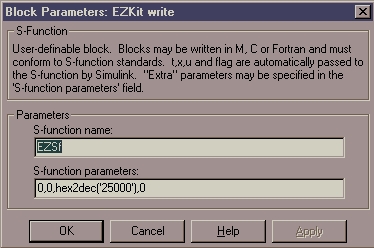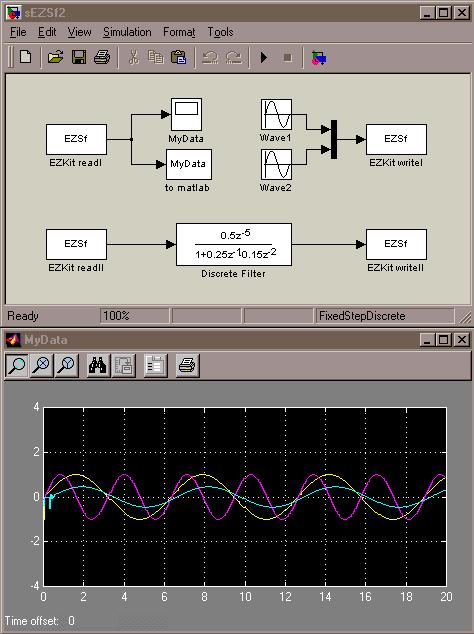Preface
The toolbox consists of two dll-mex
files (an executable module that runs within Matlab),
that connect to EZKit Lite (SHARC
based developing board). The plug-in is designed for Matlab 5.x and Simulink
3, and uses modules from the well known Tim Wall's communicator.
The tool is useful when you develop
and debug new algorithms within Matlab before their porting to the DSP.
In a later stage you can use Matlab/Simulink to visualise data, and to
change parameters and coefficients. In addition, you can experiment using
Simulink within a control loop, however, because the real time is not
guaranteed, this mode is useful only for lab-based experiments.
How to use the toolbox
The toolbox consists of two dll files:
ezmex.dll
and ezsf.dll. The first dll is designed for
Matlab, while the second is for Simulink. In addition, four m-files are
provided: DSPOpen,
DSPClose,
DSPRead,
and DSPWrite. These
interface ezmex.dll, and
their function is described in the following section.
EZKit
Lite to Matlab: To
send and receive data to/from Matlab, use ezmex.dll
in
one of its four modes; these are grouped as follows:
DSPOpen
This function initialises a communication link
with the kernel on the DSP board. The format is: Handle=ezmex('COM1','DSPOpen');
The
dll module accepts two parameters and returns one. The first input parameter
is the communication port on the host, and accepts values: 'COM1' or 'COM2';
the second parameter specifies the operation (DSPOpen). A return parameter
is the serial port's handle. All other functions use this parameter. By
default the module uses the maximum communication speed of 115200b/s. However,
if by any reason you want to connect with speed of 9600 b/s, use the format:
Handle=ezmex('COM1','DSPOpen',9600);
Instead of using the dll file directly,
you may use the provided m-file DSPOpen, with
format: DSPOpen('COMx');
The default speed
in this case is 115200b/s, and the serial port's handle is stored within
the Matlab's workspace as a global variable.
DSPClose
This function closes the communication link that has been previously opened
with DSPOpen. The format is: ezmex(Handle,'DSPClose');
The
input parameters are: the serial port's handle (returned by
DSPOpen),
and the parameter that specifies this operation. The m-file provided
for this function is: DSPClose;
DSPReadWith
this function you can read 32-bit data from the SHARC's internal memory.
The format is: Data=ezmex(Handle,'DSPRead',ADDRESS,LENGTH);
In
this mode, the dll file accepts four parameters: the serial port's handle;
the parameter that specifies the operation; ADDRESS is a valid address
from the SHARC's internal memory space, and LENGTH is the number of words
we want to transfer. For example, if you are performing 512 point FFT,
and your MyFFTResult buffer is located at address 0x25000, you can
observe the result by calling: MyFFTResult=ezmex(Handle,'DSPRead',hex2dec('25000'),512);
You can also use the provided m-file,
which has a format: MyFFTResult=DSPRead('25000',512);
The first parameter specifies the address, and the second specifies the
number of words to be transferred.
DSPWrite
With this function you can write 32-bit data to the SHARC's internal memory.
The format is: ezmex(Handle,'DSPWrite',ADDRESS,DATA);
The
serial port's handle is the first input to the function; ADDRESS specifies
the internal address where the DATA will be transferred. The number of
words to be transferred is equal to the length(DATA); DATA must
be a row-vector and a single precision. For example, if you want to update
the coefficients, organised as a vector, of your FIR filter starting at
address 0x25010, the format is: ezmex(Handle,'DSPWrite',hex2dec('25010'),single(MyFIRCoef));
The
vector MyFIRCoef is in the form: MyFIRCoef=[a1, a2, a3, ..., an];
An m-file is provided that performs
the same operations. It format is: DSPWrite('25010',MyFIRCoef);
where
the first parameter is the address, and the second is the data to be transferred.
A quick
start: This set of operations demonstrates the basic use of the
toolbox. It opens the communication, writes 10 variables, and reads 10
variables from the same location. The operations are:
1. Open the
communication: DSPOpen('COMx').
2. Write the
data:
vTx=0.123*[1:10]; DSPWrite('25000',vTx);
3. Read the
data:
vRx=DSPRead('25000',10);
4. Do your
own reading and writing.
5. Close the
communication: DSPClose;
EZKit
Lite to Simulink: If you want to send and receive data from/to
EZKit Lite using Simulink use ezsf.dll. This
S-function accepts four parameters, as shown in the figure bellow. The
first parameter determines the direction of the operation; value 1 determines
operation reading from the kit, while value 0 specifies writing to the
kit. The second parameter determines the communication port on the host:
value 0 for COM1, and value 1 for COM2. The third parameter determines
the address from(to) where data will be transferred. The last parameter
is necessary only for reading, and determines the number of variables to
be transferred from EZKit to Simulink (up to 500 points/block are supported
in this version). The number of data transferred to EZKit Lite is determined
from the width of the input bus to the S-block.

A
quick start: There are three
Simulink files provided together with the toolbox that demonstrate the
basic features and give an idea how to use the toolbox. One of these demonstrations
is shown in the figure bellow. Here Simulink writes to three memory locations
and reads from the same three memory locations.

Notes and tips
1. The function
single(x)
converts a variable
x from a double to a single precision (see double(x)
if necessary)
2. To find where your variables
are located within the DSP's internal memory, generate a map-file during
the linking by adding the option -m or -map (check your documentation for
more information).
3. If you want to observe a given
location in a hexadecimal format, type format hex in Matlab, read
and visualise the data.
4. If the DSP is reset before closing
the communication with DSPClose, restart the
DSP and clear the dll by executing clear ezmex in Matlab.
5. Before using Simulink for communication,
you have to close (if opened) the communication initialised from Matlab.
6. Before using the dlls, you MUST
close all programs that use the serial port !!! If the KIT is booted from
a DOS-mode software, you have to close the DOS-window after booting. If
you are using the dll for MATLAB, and you want to start a communication
with Simulink, you have to first close the MATLAB link with DSPClose.
After a resynchronisation in the communication, restart the board, close
all software that use the serial port, clear the ezmex.dll from MATLAB
by: clear ezmex, and then start another session.
Downloads and installation:
Download and unzip the file: EZMEX.ZIP
in any directory, for example in ...\Matlab\toolbox\EZMex\. The archive
consists of: two dll files, four m-files, three Simulink demo-files, and
this help file. When you start Matlab, change your default path to the
location where these files are installed or add this location to the Matlab's
Path list. For a test, perform the "quick start" steps given above.
Conclusion
Please note that this software is
designed and meant to be used only for research and educational purposes.
Please send any comments or questions
to: A.Pechev@zoom.co.uk
AP(c), 2000

